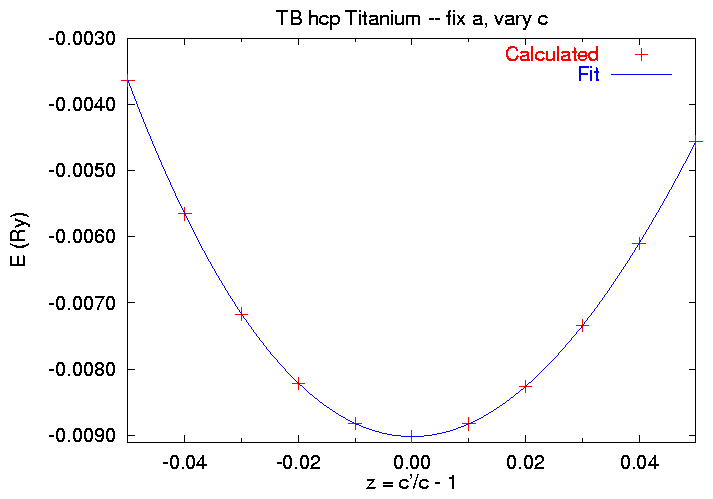
Last Modified 17 December 1999
So far we've looked at the energy of the hcp Titanium lattice as a function of
We can exploit one more strain which keeps the full P63/mmc symmetry of the hcp lattice. In this case we fix the lattice constant a and allow c to vary:c ---> c' = c (1 + z) , (1)
then according to our elastic constant tutorial we've constructed a strain
e1,2 = 0 ; e3 = z ; e4-6 = 0 , (2)
which leads to the energy-strain relationship
E(z) = E0 + ½ V0 C33 z2 + O[z3] (3)
So now we: calculate E(z) at several points z, and determine the the elastic constant from a polynomial fit to the data. We'll do this in the directory work/c33. Again, the pre-defined strain types table does not have an entry for the strain (2), so we'll have to use option ``1'' and provide all six of the ei. Thus the first calculation in the work/c33/SKIN file looks like this:
Mode=3 (Calculate energy only -- no pressure)
0.005 0.500 (T_{Fermi}, Eigenvalue cutoff for P calculation)
../ti_par
Titanium HCP (A3) -- Fixed a
1.61326030 -0.050 (We'll use the label to indicate c/a and strain)
0.00 (Electrons in addition to nominal Ti charge (=4/atom))
-3 (hexagonal lattice, read in V and c/a)
220.088 1.61326030 (V in Bohr^3 and c/a)
1 (General strain)
0 0 -0.050 0 0 0 (the strain factors)
2 (Atoms in the unit cell)
4 4 4 (Neighbor search cutoff indices)
F (Logical variable -- no internal displacements)
1 0.33333333333333333 0.66666666666666667 0.25 0 0 0 (Atom 1 in lattice coord.)
1 0.66666666666666667 0.33333333333333333 0.75 0 0 0 (Atom 2 in lattice coord.)
NEWSYM=T (Generate new set of k-points)
LATTIC=4 (Lattice type / Next is spacegroup file name:)
../spcgp1.hcp
ILAT=T (Space group file in lattice Coordinates)
-1313 (Read k-point generation information from file)
../kmesh.194
We use strain option 1, so we have to specify all six ei, according to (2). When we run the code for a full set of strains, we find
$ cat SKENG 1.61326030 -0.050 209.083600 .134069317 -.003642696 1.61326030 -0.040 211.284480 .133000251 -.005655484 1.61326030 -0.030 213.485360 .131907130 -.007168730 1.61326030 -0.020 215.686240 .130779913 -.008212985 1.61326030 -0.010 217.887120 .129627497 -.008820742 1.61326030 0.000 220.088000 .128472502 -.009018141 1.61326030 0.010 222.288880 .127334905 -.008825389 1.61326030 0.020 224.489760 .126223305 -.008260279 1.61326030 0.030 226.690640 .125131816 -.007343170 1.61326030 0.040 228.891520 .124050273 -.006100872 1.61326030 0.050 231.092400 .122978185 -.004563108
We'll use a modification of the fitting procedure we used in E(a) at fixed c case, using gnuplot to fit this data to the polynomial
E(x) = E0 + ½ V0 x2 [ C33 + x ( A + x ( B + x C))] , (4)
where A, B, and C are higher order elastic constants. When we run the fitting script we get
$ gnuplot c33fit.gnu Starting from v0 = 220.088 and e0 = -0.009018141 Change if appropriate Pressto continue [Fitting information deleted. See fit.log] C_{33} = 261.217391809226 GPa Press to quit $

So in this section we've found that
Go back to the Example X home page.
Look at other examples.
Get other parameters from the Tight-binding periodic table.
Return to the static Reference Manual.